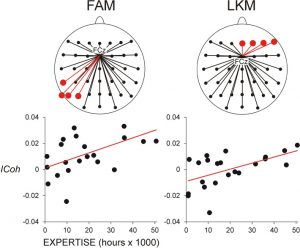Different Meditation Styles Affect the Medial Frontal Brain Network Differently
By John M. de Castro, Ph.D.
“meditation has a variety of neurological benefits, from changes in brain volume to decreasing activity in parts of the brain involved with stress.” – Ashley Welch
Mindfulness training has been shown to improve health and well-being. It has also been found to be effective for a large array of medical and psychiatric conditions, either stand-alone or in combination with more traditional therapies. How exactly mindfulness practices produce their benefits is unknown. But it is known that meditation practice alters brain activity.
There are a number of different types of meditation. Classically they’ve been characterized on a continuum with the degree and type of attentional focus. In focused attention meditation, the individual practices paying attention to a single meditation object, usually the breath. In open monitoring meditation, the individual opens up awareness to everything that’s being experienced including thoughts regardless of its origin. In Loving Kindness Meditation the individual
systematically pictures different individuals from self, to close friends, to enemies and wishes them happiness, well-being, safety, peace, and ease of well-being. It is suspected but not known that different forms of meditation practice can produce different changes in brain activity.
One way is to measure changes in the electroencephalogram (EEG), the rhythmic electrical activity that can be recorded from the scalp. In today’s Research News article “Attentional and cognitive monitoring brain networks in long-term meditators depend on meditation states and expertise.” (See summary below or view the full text of the study at: https://www.ncbi.nlm.nih.gov/pmc/articles/PMC7921394/ ) Yordanova and colleagues recruited highly experienced meditators who practiced focused attention meditation, open monitoring meditation, and Loving Kindness Meditation in a balanced way. They had their electroencephalograms (EEG) recorded while at rest and while performing the 3 meditation types for 3 minutes each.
They found that the Frontal-Parietal network, that is thought to underlie attentional mechanisms did not differ between meditation types. But there was increased connectivity between the right hemisphere frontal and left hemisphere parietal areas. On the other hand, the Medial Frontal network that is thought to underlie cognitive control and monitoring mechanisms had different activity patterns with the different meditation types. During focused attention meditation was increased synchronization in the parietal regions whereas during Loving Kindness Meditation it increased in the right frontal regions.
These are interesting findings that demonstrate that highly experienced meditators have distinct changes in the activity of their brains during meditation regardless of type. But in areas associated with cognitive monitoring mechanisms, difference appear. During focused attention meditation and Loving Kindness Meditation there are different patterns of activity. To some extent this is not surprising in that the two meditation types involve specific focuses. But Loving Kindness Meditation is emotionally focused while focused attention meditation is breath sensation focused and these require different kinds of cognitive control. These differences may underlie the different medial frontal activities.
It should be noted that these patterns are quite different from those of inexperienced meditators and that the greater the amount of practice the greater the neural activations. It would be expected that highly experienced meditators would have greater focus and much less mind wandering during meditation than inexperience meditators and this would produce different patterns of neural activation.
So, different meditation styles affect the medial frontal brain network differently.
“Meditation benefits for the brain are abundant. Meditating strengthens neural connections and can literally change the configuration of these networks. With regular practice, you can cultivate a more resilient neurobiology.” – Ask the Scientists
CMCS – Center for Mindfulness and Contemplative Studies
This and other Contemplative Studies posts are also available on Google+ https://plus.google.com/106784388191201299496/posts and on Twitter @MindfulResearch
Study Summary
Yordanova, J., Kolev, V., Nicolardi, V., Simione, L., Mauro, F., Garberi, P., Raffone, A., & Malinowski, P. (2021). Attentional and cognitive monitoring brain networks in long-term meditators depend on meditation states and expertise. Scientific reports, 11(1), 4909. https://doi.org/10.1038/s41598-021-84325-3
Abstract
Meditation practice is suggested to engage training of cognitive control systems in the brain. To evaluate the functional involvement of attentional and cognitive monitoring processes during meditation, the present study analysed the electroencephalographic synchronization of fronto-parietal (FP) and medial-frontal (MF) brain networks in highly experienced meditators during different meditation states (focused attention, open monitoring and loving kindness meditation). The aim was to assess whether and how the connectivity patterns of FP and MF networks are modulated by meditation style and expertise. Compared to novice meditators, (1) highly experienced meditators exhibited a strong theta synchronization of both FP and MF networks in left parietal regions in all mediation styles, and (2) only the connectivity of lateralized beta MF networks differentiated meditation styles. The connectivity of intra-hemispheric theta FP networks depended non-linearly on meditation expertise, with opposite expertise-dependent patterns found in the left and the right hemisphere. In contrast, inter-hemispheric FP connectivity in faster frequency bands (fast alpha and beta) increased linearly as a function of expertise. The results confirm that executive control systems play a major role in maintaining states of meditation. The distinctive lateralized involvement of FP and MF networks appears to represent a major functional mechanism that supports both generic and style-specific meditation states. The observed expertise-dependent effects suggest that functional plasticity within executive control networks may underpin the emergence of unique meditation states in expert meditators.
https://www.ncbi.nlm.nih.gov/pmc/articles/PMC7921394/
